Some of the most common questions (and debates) that come across my desk involve Twitter hashtags. What is a hashtag? Should I create one for my event? How do I use it? What should my hashtag be?
I’m going to attempt to give a fairly comprehensive guide to hashtags, and how to use them at the University of Michigan.
WHAT IS A HASHTAG?
According to the Twitter Help Center (support.twitter.com), the definition of a hashtag is:
The # symbol, called a hashtag, is used to mark keywords or topics in a Tweet. It was created organically by Twitter users as a way to categorize messages.
– People use the hashtag symbol # before a relevant keyword or phrase (no spaces) in their Tweet to categorize those Tweets to help them show more easily in Twitter search.
– Clicking on a hashtagged word in any message shows you all the other Tweets marked with that hashtag.
– Hashtags can occur anywhere in the Tweet.
Using hashtags correctly:
– If you Tweet with a hashtag on a public account, anyone who does a search for that hashtag may find your Tweet.
– Don’t #spam with #hashtags. Don’t over-tag a single Tweet — Twitter best practices recommend using no more than two hashtags per Tweet.
– Use hashtags only on Tweets relevant to the topic.
WHAT HASHTAG SHOULD I USE?
When in doubt, the main hashtags for U-M are: #umich, #goblue, #UMsocial, #umicharts, and #UMinstagram. Usually, if your tweet is related to the university, you should be using one of those five hashtags.
#umich: This is the catch-all. Instead of writing out University of Michigan, you can write #umich, and people will know what you’re talking about. You can also choose to use @umich, but in that case you’re “mentioning” the @umich account, which means that it won’t be part of the hashtag search, but will instead be seen faster by the managers of the account.
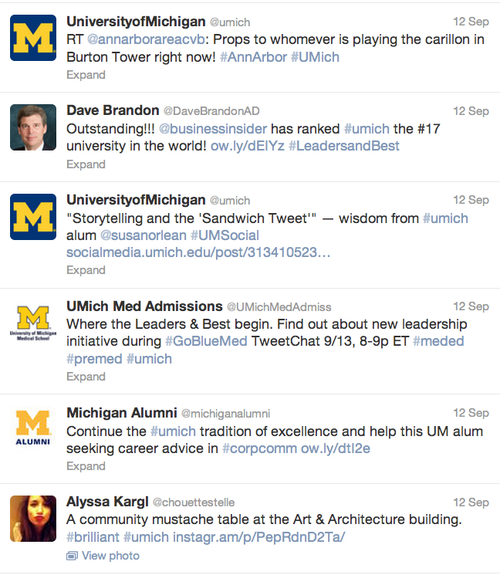
#goblue: The “official” hashtag of U-M athletics, this tag gets a lot of use beyond the field. During major sports events, it’s easy to follow along even if you don’t have access to a TV or radio simply by following the #goblue hashtag. There is always plenty of conversation around the game, both by professionals and fans; usually enough to make it clear what’s going on down to the second.
But this tag is also used a lot outside of athletics to show Michigan pride.
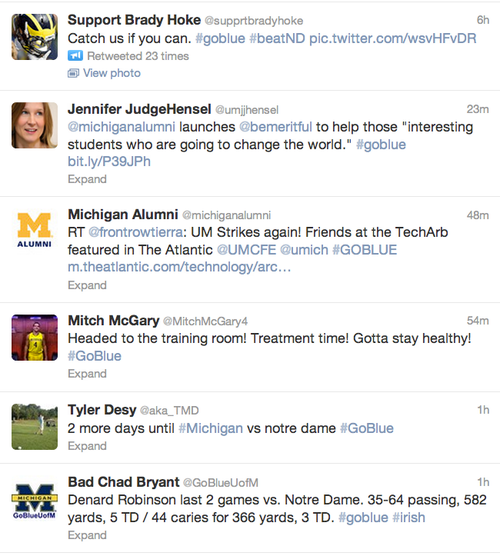
#umsocial: This tag is used when discussing social media-related topics, and is also often used for events on campus. For example, at Communicator’s Forum meetings, attendees are encouraged to tweet their reactions, thoughts and opinions using the #UMSocial tag. The result is a robust conversation that is easily trackable.


#umicharts: This is our newest tag, for arts-related events and topics, such and university concerts, exhibitions, and shows.
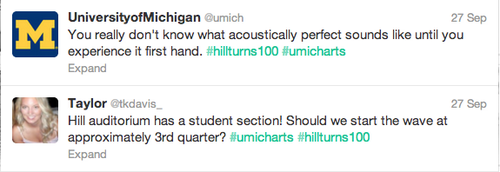
#UMInstagram: If you’re an Instagram user (and you should be — it’s fun!), you can tag your photos with #UMInstagram, and when you tweet it anyone following that tag will see the photos. That includes the community manager for the main @umich account, so there’s a good chance your photo/tweet will be re-tweeted or posted by @umich.
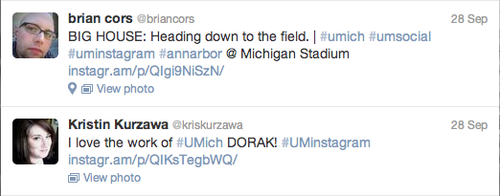
EVENTS
If you do create a hashtag for your event, or you’re at an event with a hashtag and you’re tweeting, you should use the appropriate main U-M hashtag in conjunction with the event tag to ensure that your tweets are part of the Michigan conversation on Twitter.

If you’re speaking at a conference, you can ask people to use a U-M hashtag in addition to the conference hashtag so that their tweets stay with ours.

SO WHAT’S UP WITH THE RANDOM HASHTAGS THAT DON’T SEEM TO BE RELEVANT TO ANYTHING?
That’s just it. They’re irrelevant. It has become popular on Twitter, and sometimes off-Twitter, to use hashtags to summarize something funny about a statement, or throw in a joke.


Do not be afraid of these hashtags. You can politely ignore them or hop on the bandwagon as you wish.
TRENDING HASHTAGS
Twitter always lists topics and hashtags that are very popular at the moment. These are called “trending.” There’s usually one in there that’s promoted, which means it was paid for. There are usually a couple of fun/silly ones that you can jump in on if it suits you.
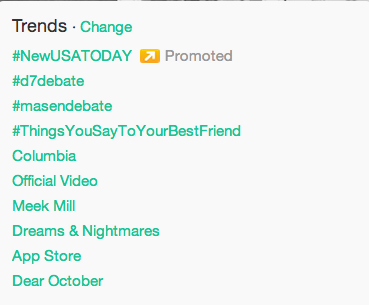
For example you could tweet:
#ThingsYouSayToYourBestFriend are sometimes little, white lies.
or
“Sure, you can borrow my favorite dress in the world that I know you won’t give back” #ThingsYouSayToYourBestFriend
In doing so, your tweets become part of a huge, global conversation. Someone might see them, or not.
HOW DO I FOLLOW HASHTAGS?
The best way to follow hashtags, as well as monitor your own Twitter activity, is to use a third-party client, like Tweetdeck (which is now owned by Twitter) or Hootsuite (there are others, and you should definitely poke around and try different options before you decide on one). You can also use the Twitter search function, but it is much more time-consuming.
At UMSocial we use Hootsuite, so I’ll focus on that. Hootsuite is free for a basic membership, and it’s web-based, which means you can use it from any computer just by signing on. You can add more people to your membership; you just have to pay for them.
As you can see below, you can monitor different accounts, different hashtags and keyword searches as well as post, re-tweet and favorite tweets all from Hootsuite.
Monitoring hashtags is a great way to follow multiple conversations and even engage in them.
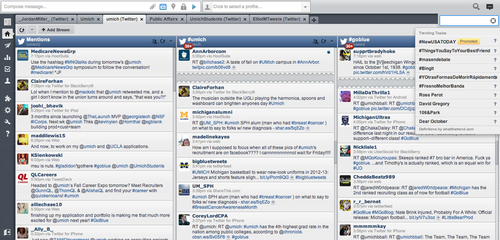
That’s the end of #Hashtags — #Why, #When, #What, #How. If you have any questions, please direct them to UMsocial@umich.edu. Thanks!


